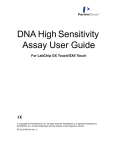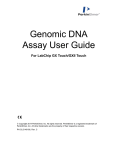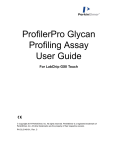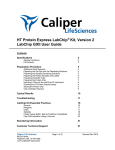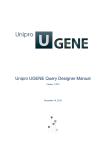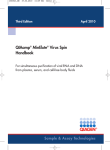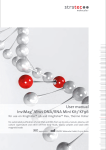Download DNA 5K Assay User Guide
Transcript
DNA 5K Assay User Guide For LabChip GX Touch/GXII Touch Copyright 2014 PerkinElmer, Inc. All rights reserved. PerkinElmer is a registered trademark of PerkinElmer, Inc. All other trademarks are the property of their respective owners. PN CLS140147, Rev. C 2 Contents Specifications ......................................................................................................... 3 Assay Specifications .......................................................................................... 3 Sample Conditions ............................................................................................. 3 Kit Contents ....................................................................................................... 4 Safety Warnings and Precautions.......................................................................... 6 Preparation Procedures ......................................................................................... 7 Additional Items Required .................................................................................. 7 Preparing the Gel-Dye Solution .......................................................................... 7 Preparing the DNA Samples, DNA Ladder and the Buffer Tube .......................... 8 Preparing the Chip ............................................................................................. 9 Inserting a Chip into the LabChip GX Touch/GXII Touch Instrument ................. 10 Running the Assay ........................................................................................... 13 Storing the Chip ............................................................................................... 16 Chip Cartridge Cleaning ................................................................................... 17 Results .................................................................................................................. 18 DNA 5K Ladder Result ..................................................................................... 18 Troubleshooting ................................................................................................... 19 LabChip Kit Essential Practices........................................................................... 25 General ............................................................................................................ 25 Reagents .......................................................................................................... 26 Chips ................................................................................................................ 26 Samples ........................................................................................................... 29 Chip Well Aspiration Using a Vacuum ................................................................. 30 Customer Technical Support ............................................................................... 31 Licenses and Rights of Use ................................................................................. 32 PN CLS140147, Rev. C DNA 5K Assay User Guide Specifications 3 Specifications Assay Specifications Table 1. Assay Specifications Sizing Range 100-5000bp Sizing Resolutiona ± 10% from 150-500 bp ± 15% from 100-150 bp, 500-1500 bp ± 20% from 1500-5000 bp Sizing Accuracy ± 10% Sizing Precision 5% CV Linear Concentration Range 0.25 ng/µL - 50 ng/µL per fragment Sensitivity 0.25 ng/µL Maximum Total DNA 80 ng/µL total, 50 ng/µL per fragment Concentration Quantitation Accuracy ± 30% or ± 1 ng/µL, whichever is greater Quantitation Precision 20% CV a. Resolution is defined as half height or better separation of two peaks. Actual separation performance can depend on the sample and application. Peaks that are resolved less than half height can still be accurately identified by the system software. Sample Conditions Table 2. Sample Conditions Additives PN CLS140147, Rev. C PerkinElmer recommends that BSA and detergents exceeding 0.05 mg/mL and 0.01% (v/v) respectively in concentration not be used. Higher concentrations can result in chip failure. In addition, non-aqueous solvents are not compatible with DNA LabChip protocols DNA 5K Assay User Guide Specifications 4 Table 2. Sample Conditions(Continued) Particulates All sample plates should be spun down prior to analysis. All buffers should be filtered with a 0.22 µm cellulose acetate filter. Salt Concentration Total salt concentration must not exceed 125 mM. Plasmids Plasmid concentration in samples must be below 20 ng/µL. Please note that although the DNA Assays cannot analyze plasmids, the presence of plasmids above 20 ng/µL can interfere with assay results Kit Contents Storage: When not in use, store chips and reagents refrigerated at 4°C. Do not leave chips and reagents unrefrigerated overnight. DNA 5K Reagent Kit Part Number CLS760675 Each kit contains enough reagents for 20 Low-throughput (LT) or 10 High-throughput (HT) chip preparations. Up to 48 samples can be tested with a LT chip preparation. Up to 384 samples can be tested with a HT chip preparation. Table 3. Reagent Kit Contents, PN CLS760675 Reagent Vial Quantity DNA Dye Concentrate Blue 1 vial, 0.09 mL Chip Storage Buffer White 9 vials, 1.8 mL each DNA Gel Matrix Red 5 vials, 1.1 mL each 10X DNA Ladder Yellow 1 vial, 0.26 mL DNA Marker Green 1 vial, 1.6 mL Table 4. Consumable Items Item Supplier and Catalog Number Quantity Spin Filters Costar, Cat. # 8160 10 Ladder Tubes Genemate, Cat. # C-3258-1 20, 0.2 mL Detection Window VWR, Cat. # 21912-046 Cleaning Cloth PN CLS140147, Rev. C 1 DNA 5K Assay User Guide Specifications 5 Table 4. Consumable Items (Continued) Item Supplier and Catalog Number Quantity Swab ITW Texwipe®, Cat. # TX758B 3 Buffer Tubes E&K Scientific, Cat. # 697075NC 20, 0.75 mL Table 5. DNA LabChips Item Catalog Number DNA 5K/RNA/CZE Chip for use with GX Touch/GXII Touch HT Cat. # 760435 DNA 5K/RNA/CZE Chip for use with GX Touch/GXII Touch 24 Cat. # CLS138949 PN CLS140147, Rev. C DNA 5K Assay User Guide Safety Warnings and Precautions 6 Safety Warnings and Precautions WARNING! For Research Use Only. Not recommended or intended for diagnosis of disease in humans or animals. Do not use internally or externally in humans or animals. CAUTION We recommend that this product and components be handled only by those who have been trained in laboratory techniques and that it is used in accordance with the principles of good laboratory practice. As all chemicals should be considered as potentially hazardous, it is advisable when handling chemical reagents to wear suitable protective clothing, such as laboratory overalls, safety glasses, and gloves. Care should be taken to avoid contact with skin or eyes. In case of contact with skin or eyes, wash immediately with water WARNING! Dye Concentrate contains DMSO. S24/25: Avoid contact with skin and eyes. PN CLS140147, Rev. C DNA 5K Assay User Guide Preparation Procedures 7 Preparation Procedures Additional Items Required • 18 megohm, 0.22-µm filtered water (Milli-Q® or equivalent). • 70% isopropanol solution in DI water. • Bio-Rad Hard-Shell® 384-well Skirted PCR Plates, Cat. # HSP38XX (recommended) • PerkinElmer Hard-Shell thin-wall 96-well skirted PCR plate (blue), Cat. # 6008870 (recommended) Note: Allow the chip and reagents to equilibrate to room temperature for about 20-30 minutes before use. Preparing the Gel-Dye Solution Notes: The Dye Concentrate contains DMSO and must be thawed completely before use. One vial of DNA Gel Matrix (red cap ) is good for 4 Lowthroughput chip preparations or 2 High-throughput chip preparations. Up to 48 samples can be tested with a LT chip preparation. Up to 384 samples can be tested with a HT chip preparation. 1 Vortex the thawed DNA Dye Concentrate (blue cap 15 seconds before use. ) for 10- 2 Transfer 13 µL of DNA Dye Concentrate (blue cap of DNA Gel Matrix (red cap ). ) to 1 vial 3 Vortex the solution until it is well mixed and spin down for a few seconds. 4 Transfer the mixture into two spin filters (approximately 550 µL each). 5 Centrifuge at 9300 rcf for 7.5 minutes at room temperature. 6 Discard filters, label and date the tubes 7 Store in the dark at 4°C. Use within 3 weeks. PN CLS140147, Rev. C DNA 5K Assay User Guide Preparation Procedures 8 Preparing the DNA Samples, DNA Ladder and the Buffer Tube Notes: DNA Ladder should be prepared in the same buffer as your DNA samples. A buffer mismatch between sample and ladder may lead to inaccurate quantitation and sizing. DNA sample buffer solution is the user's DNA buffer such as PCR buffer, etc. Standard Sample Workflow Buffer Tube Ladder Tube Sample Well A1 Ladder Tube Buffer Tube Figure 1. Locations of the Buffer Tube and Ladder Tube in the GX Touch/GXII Touch instrument. Preparing the Ladder Tube 1 Gently vortex DNA Ladder (yellow cap Briefly spin the ladder vial. 2 In the provided 0.2 mL Ladder Tube, add 12 µL of DNA Ladder to 108 µL of 1X DNA sample buffer solution. Mix thoroughly by pipetting the solution up and down several times. Ensure there are no air bubbles in the Ladder Tube. 3 Insert the Ladder Tube into the ladder slot on the LabChip GX Touch/GXII Touch instrument. 4 Recommended sample volumes are 25 µL for a 384-well plate or 40 µL for a 96-well plate. PN CLS140147, Rev. C ) for 10 seconds. DNA 5K Assay User Guide Preparation Procedures 9 Preparing the Buffer Tube 1 Add 750 µL of 1X DNA Sample Buffer solution to the 0.75 mL Buffer Tube provided with the reagent kit. Ensure there are no air bubbles in the Buffer Tube. 2 Insert the Buffer Tube into the buffer slot on the LabChip GX Touch/GXII Touch instrument. Preparing the Chip 1 Allow the chip to come to room temperature. 2 Use a pipette tip attached to a vacuum line to thoroughly aspirate all fluid from the chip wells (see Figure 2). For more details on how to set up a vacuum line see page 30. Figure 2. Using a vacuum to aspirate the chip wells is more effective than using a pipette. 3 Rinse and completely aspirate each active chip well (1, 3, 4, 7, 8 and 10) twice with water. Do not allow active wells to remain dry. 4 If any water spills onto the top and bottom chip surfaces during rinsing, aspirate using the vacuum line. DO NOT run the tip over the central region of the detection window. Use the provided Detection Window Cleaning Cloth dampened in water (Milli-Q ® or equivalent) or alcohol to clean chip detection window as needed. 5 Using a reverse pipetting technique, add Gel-Dye solution to chip wells 3, 7, 8 and 10 as shown in Figure 3 (Low-throughput) or Figure 4 (High-throughput). PN CLS140147, Rev. C DNA 5K Assay User Guide Preparation Procedures Figure 3. Reagent placement for Low-throughput (up to 48 samples). 6 10 Figure 4. Reagent placement for High-throughput (up to 384 samples). Add DNA Marker (green cap ) to chip well 4 as shown in Figure 3 (Low-throughput) or Figure 4 (High-throughput). For the High-throughput chip preparation add 50 µL DNA Marker for 96-well plates and 120 µL DNA Marker for 384-well plates or multiple 96-well plate analysis. Note: The marker well may need to be replenished if the chip is in idle mode on the instrument for an extended period of time. 7 Make sure the rims of the chip wells are clean and dry. 8 IMPORTANT: Ensure chip well 1 (waste well) is empty before placing the chip into the instrument. Note: Use the Low-throughput protocol when running the LabChip GX Touch/GXII Touch 24 instrument. Inserting a Chip into the LabChip GX Touch/GXII Touch Instrument 1 Check that the sample plate, Buffer Tube, and Ladder Tube are properly placed on the instrument. 2 Remove the chip from the chip storage container and inspect the chip window. Clean BOTH sides of the chip window with the PerkinElmer-supplied clean-room cloth dampened with a 70% isopropanol solution in DI water. 3 Touch the Unload Chip button on the Home screen. PN CLS140147, Rev. C DNA 5K Assay User Guide Preparation Procedures 11 Figure 5. Home screen. 4 Insert the chip into the LabChip GX Touch/GXII Touch instrument (Figure 6) and close the chip door securely. Figure 6. Chip in the LabChip GX Touch/GXII Touch instrument. 5 Touch the Load Plate button on the Home screen (Figure 5) to retract the sample plate and send the sipper to the Buffer Tube. Note: Do not keep the chip door open for any length of time. Dye is sensitive to light and can be photobleached. 6 PN CLS140147, Rev. C The Assay Choice window opens (Figure 7). Touch the desired assay and then touch OK. DNA 5K Assay User Guide Preparation Procedures 12 Figure 7. Assay Choice menu. Notes: If performing multiple runs in a day, in between chip preparations the chip should be washed using the instrument and Chip Storage buffer as described in “Storing the Chip” on page 16. Be sure to periodically clean the O-rings on the top plate of the chip interface on the LabChip GX Touch/GXII Touch. Use the provided lint-free swab dampened with water (Milli-Q® or equivalent) to clean the O-rings using a circular motion. Allow the O-rings to dry before inserting a chip. PN CLS140147, Rev. C DNA 5K Assay User Guide Preparation Procedures 13 Running the Assay Note: Chips can be primed independently from running assays. Touch the Prime button on the Home screen. Make sure the Buffer Tube is placed on the instrument. Figure 8. Chip priming screen. 1 Touch the Run button (see Figure 8). 2 Select the appropriate assay type (see Figure 7), plate name, well pattern, and whether to read wells in columns or rows. Select number of times each well is sampled under Adv. Settings (Figure 9). Touch the green arrow button. PN CLS140147, Rev. C DNA 5K Assay User Guide Preparation Procedures 14 Figure 9. Selecting wells. 3 PN CLS140147, Rev. C In the Setup Run tab, select the operator name, the option to read barcode, the destination of the file, the inclusion of sample names, expected peaks, and excluded peaks and the filename convention. Select Auto Export to export results tables automatically (Figure 10). Touch the green arrow button. DNA 5K Assay User Guide Preparation Procedures 15 Figure 10. Run setup screen. 4 Touch Start to begin the run (Figure 11). Figure 11. Starting a run. PN CLS140147, Rev. C DNA 5K Assay User Guide Preparation Procedures 16 Storing the Chip After use, the chip must be cleaned and stored in the chip container. The procedure below can be conducted the following day when running overnight. 1 Place the chip into the plastic storage container. The sipper should be submerged in the fluid reservoir. 2 Remove the reagents from each well of the chip using vacuum. 3 Each active well (1, 3, 4, 7, 8 and 10) should be rinsed and aspirated twice with water (Milli-Q® or equivalent). 4 Add 120 µL of DNA Storage Buffer (white cap wells. 5 Place the chip in the LabChip GX Touch/GXII Touch instrument and touch the Wash button in the upper right corner in the Home Screen. ) to the active Figure 12. Wash screen. 6 Remove the chip from the instrument and place it in the plastic storage container. Add an additional amount of Storage Buffer to well 1. 7 Cover the wells with Parafilm® to prevent evaporation and store at 4°C. Storage of a chip with dry wells may cause it to become clogged. PN CLS140147, Rev. C DNA 5K Assay User Guide Preparation Procedures 17 Chip Cartridge Cleaning 1 2 PN CLS140147, Rev. C Daily a Inspect the inside of the chip cartridge and O-rings for debris. b Use the provided lint-free swab dampened with water (MilliQ® or equivalent) to clean the O-rings using a circular motion. If the O-rings stick to the chip or a pressure leak is detected, perform the more extensive monthly cleaning procedure. Monthly a To reduce pressure leaks at the chip interface, clean the Orings frequently. Remove the O-rings from the top plate of the chip interface on the LabChip GX Touch/GXII instrument. Soak O-rings in water (Milli-Q ® or equivalent) for a few minutes. Clean the O-ring faces by rubbing between two fingers. Wear gloves. b To reduce the occurrence of current leaks, clean the chip interface frequently. Clean the top plate of the chip interface using the provided lint free swab dampened with water (MilliQ® or equivalent). c Allow the O-rings and chip interface to air dry. Reinsert the O-rings into the chip cartridge. DNA 5K Assay User Guide Results 18 Results DNA 5K Ladder Result The electropherogram of a typical DNA 5K ladder is shown in Figure 13. Between the upper and lower markers, peaks in order of increasing migration time correspond to ladder fragments of 100, 300, 500, 700, 1100, 1900, 2900, and 4900 bp. . Lower Marker Upper Marker Figure 13. DNA 5K ladder electropherogram produced using the Standard Sample Workflow. PN CLS140147, Rev. C DNA 5K Assay User Guide Troubleshooting 19 Troubleshooting Note: Some of the data examples shown in this section were generated with assays other than the assay described in this user guide. Symptom: No ladder or sample peaks but marker peaks detected. Note: The lower marker peak height will most likely be greater than normal height. Possible causes: 1 Air bubble in sipper introduced during chip priming. What to do: 1 Reprime the chip. See “LabChip Kit Essential Practices” on page 25 for instructions on how to reprime the chip. Symptom: Missing sample, ladder and marker peaks. Possible causes: 1 Clog in sipper or marker channel of chip. What to do: 1 Reprime the chip. See “LabChip Kit Essential Practices” on page 25 for instructions on how to reprime the chip. Symptom: Ladder detected but no sample peaks. Possible causes: 1 The sipper is not reaching the sample due to low sample volume in the well of the plate. 2 If the missing sample peaks occurred only in a few wells of the plate, check those wells for air bubbles. 3 The sipper is not reaching the sample due to an incorrect capillary height setting or incorrect plate definition. 4 If the plate has been uncovered for some time, sample evaporation might have occurred. 5 Debris from the sample or sample prep is clogging the sipper. What to do: 1 PN CLS140147, Rev. C Add more sample to the well. DNA 5K Assay User Guide Troubleshooting 20 2 Manually insert a larger volume pipette tip (~100 µL) into the sample well and dislodge the bubble. Rerun these sample wells. 3 Check the plate definitions. 4 Check the sample wells, especially around the edge of the plate where evaporation is fastest, and make a fresh plate if volumes are low. 5 If you suspect there may be debris in your samples, spin the sample plate down in a centrifuge (e.g. 3000 rcf for 5 minutes). Unclog the sipper by repriming the chip. See “LabChip Kit Essential Practices” on page 25 for instructions on how to reprime the chip. Symptom: No ladder peaks but sample peaks and marker peaks are present. Possible causes: 1 Low or no ladder volume in the Ladder Tube. What to do: 1 Add more ladder to the Ladder Tube and restart the run. Recommended standard ladder volume is 120 µL (minimum volume is 100 µL). Symptom: No marker peaks but sample peaks are present. Possible causes: 1 No marker added to chip well 4. 2 If there is marker solution in chip well 4, the problem may be due to a marker channel clog. What to do: 1 PN CLS140147, Rev. C This may be due to not filling marker well or chip remaining idle on instrument for extended period of time. Add or replenish the marker solution in the chip using the following procedure: • Touch the Unload Chip button on the Home screen to open the chip door. • Return the chip to the chip container ensuring the sipper is immersed in fluid. • Thoroughly aspirate all fluid from chip well 4 using a vacuum line. • Ensure that chip well 4 is rinsed and completely aspirated twice with water (Milli-Q® or equivalent). • Add Marker Solution (green cap ) to chip well 4. DNA 5K Assay User Guide Troubleshooting • • 2 21 Reinsert the chip back into the instrument. Restart the run. Perform a marker channel unclogging procedure by repriming the chip. See “LabChip Kit Essential Practices” on page 25 for instructions on how to reprime the chip. Symptom: Ladder traces show up in the lanes following the ladders (delayed sip). Figure 14. Small ladder peaks in sample well caused by delayed sip. Possible causes: 1 Separation channel overloaded with sample. 2 Partial clog in the separation channel. What to do: 1 Lower the starting sample concentration. 2 Reprime the chip. See “LabChip Kit Essential Practices” on page 25 for instructions on how to reprime the chip. PN CLS140147, Rev. C DNA 5K Assay User Guide Troubleshooting 22 Symptom: Unexpected sharp peaks. Figure 15. Unexpected sharp peak. Possible causes: • Dust or other particulates introduced through sample or reagents. What to do: 1 Do one or all of the following: • Replace the 18 megohm, 0.22-µm filtered water (Milli-Q® or equivalent) water used for chip preparation. • Replace the buffer used for sample and reagent preparation. • Use a 0.22-micron filter for all water and buffers used for chip, sample, and reagent preparation. • Spin down sample plate to pellet any particulates. Symptom: Humps in several electropherograms which do not correspond to sample data. Figure 16. Humps in several electropherograms. PN CLS140147, Rev. C DNA 5K Assay User Guide Troubleshooting 23 Possible causes: 1 Electrode 7 is dirty and has contaminated the Gel-Dye mixture in well 7. What to do: 1 Before restarting the run, clean electrode 7. Remove the chip and follow the electrode cleaning procedure. We recommend using the provided swab and isopropanol to manually clean electrode 7. Symptom: Peaks migrating much faster or slower than expected. Note: Some migration time variance between chips or within a plate is considered normal chip performance. All chips are QC tested at PerkinElmer prior to shipment. Normal migration time windows for the markers are: • • DNA 5K assay Lower Marker (9 - 12 seconds) DNA 5K assay Upper Marker (18 - 19 seconds) Possible causes: 1 Incorrect Gel-Dye ratio. Migration time is sensitive to dye concentration and peaks will migrate too fast or too slow if the dye concentration in the gel is too low or too high, respectively. Note: Excess dye within the separation channel will slow down migration, and less dye in the separation channel will make peaks migrate faster. 2 Particulates from the samples may be clogging the separation channel (this will slow down migration). 3 Gel-Dye was not primed properly into the chip. What to do: 1 Prepare a fresh Gel-Dye solution. Wash and reprime the chip with the new Gel-Dye mixture. See “LabChip Kit Essential Practices” on page 25 for instructions on how to wash and reprime the chip. 2 If fast or slow migration is observed repeatedly on a new chip, contact technical support to arrange return of the chip to PerkinElmer. Please send a data file showing the failure along with the return request. PN CLS140147, Rev. C DNA 5K Assay User Guide Troubleshooting 24 3 Minimize the loading of particulates in the sample by performing a centrifuge spin of the sample plate (e.g. 3000 rcf for 5 minutes) before starting a new run. The debris may be flushed out of the chip by washing and re-priming the chip. See “LabChip Kit Essential Practices” on page 25 for instructions on how to wash and reprime the chip. 4 Check the O-rings on the top surface of the chip interface and clean if necessary. PN CLS140147, Rev. C DNA 5K Assay User Guide LabChip Kit Essential Practices 25 LabChip Kit Essential Practices To ensure proper assay performance, please follow the important handling practices described below.Failure to observe these guidelines may void the LabChip Kit product warranty.1 Note: It is important to keep particulates out of the chip wells, channels and capillary. Many of the following guidelines are designed to keep the chips particulate-free. For assay and instrument troubleshooting, refer to the LabChip GX Touch software Help file or call PerkinElmer Technical Support at 1800-762-4000. General • Allow the chip, sample plate and all reagents to equilibrate to room temperature before use (approximately 20 to 30 minutes). • Clean the O-rings in the chip interface weekly and the electrodes daily. Refer to the Instrument Users Guide Maintenance and Service section for procedures. • Avoid use of powdered gloves. Use only non-powdered gloves when handling chips, reagents, sample plates, and when cleaning the instrument electrodes and electrode block. • Calibrate laboratory pipettes regularly to ensure proper reagent dispensing. • Only the PerkinElmer-supplied clean room cloth can be used on the chip to clean the detection window. • Water used for chip preparation procedures must be 18 megohm, 0.22-µm filtered water (Milli-Q® or equivalent). • Using the “Reverse Pipetting Technique” (described next) will help avoid introducing bubbles into the chip when pipetting the gel. 1. PerkinElmer, Inc. warrants that the LabChip Kit meets specification at the time of shipment, and is free from defects in material and workmanship. LabChip Kits are warranted for 90 days from the date of shipment. All claims under this warranty must be made within thirty days of the discovery of the defect. PN CLS140147, Rev. C DNA 5K Assay User Guide LabChip Kit Essential Practices 26 Reverse Pipetting Technique Figure 17. Reverse pipetting. 1 Depress the pipette plunger to the second stop. 2 Aspirate the selected volume plus an excess amount from the tube. 3 Dispense the selected volume into the corner of the well by depressing plunger to the first stop. 4 Withdraw the pipette from the well. • Store reagents at 4°C when not in use. • The LabChip dye contains DMSO and should be thawed completely before use. It is recommended that you prepare aliquots to reduce the time required for thawing. • Gently vortex all kit reagents before use. • Dispense reagents into chip wells slowly without introducing air bubbles. Insert the pipette tip vertically and to the bottom of the chip well. • Protect the dye and Gel-Dye mixture from light. Store in the dark at 4°C when not in use. • The Gel-Dye mixture expires 3 weeks after preparation. Reagents Chips Repriming Chips Note: Buffer tubes filled with 1X DNA sample buffer or water should be placed into the instrument while priming or washing chips. PN CLS140147, Rev. C DNA 5K Assay User Guide LabChip Kit Essential Practices 27 • Touch the Unload Chip button on the Home screen to open the instrument door. Place the chip into the instrument. • Close the chip door securely and choose the corresponding assay. • Touch the Prime button on the Home screen to reprime the chip. Washing and Repriming Chips • Touch the Unload Chip button on the Home screen to open the instrument door. • Return the chip to the chip container ensuring the sipper is immersed in fluid. • Thoroughly aspirate all fluid from the chip wells using a vacuum line. • Ensure that each active well (1, 3, 4, 7, 8 and 10) is rinsed and completely aspirated twice with water (Milli-Q® or equivalent). Do not allow active wells to remain dry. • Add 120 µL of Chip Storage Buffer to each active well (1, 3, 4, 7, 8 and 10). • Place the chip in the LabChip GX Touch/GXII Touch instrument. • Close the chip door securely • Touch the Wash button on the Home screen (Figure 18). Figure 18. Wash screen. • PN CLS140147, Rev. C After the completion of the wash cycle return the chip to the chip container ensuring the sipper is immersed in fluid. DNA 5K Assay User Guide LabChip Kit Essential Practices 28 • Thoroughly aspirate all fluid from the chip wells using a vacuum line. • Ensure that each active well (1, 3, 4, 7, 8 and 10) is rinsed and completely aspirated twice with water (Milli-Q® or equivalent). Do not allow active wells to remain dry. • Add Gel-Dye solution to chip wells 3, 7, 8 and 10 using a Reverse Pipetting Technique as shown in Figure 17. • Add Marker (green cap ) to chip well 4. Use 50 µL for 96-well or 120 µL for 384- well plate analysis. Please note that the marker well may need to be replenished if the chip is in idle mode on the instrument for an extended period of time. • Place the chip into the LabChip GX Touch/GXII Touch instrument. • Close the chip door securely. • Touch the Run or Prime button on the Home screen. • If air bubbles are not dislodged after a reprime, apply a vacuum to the sipper. Perform this by filling all active wells with 100 µL of Chip Storage Buffer. Then suction the sipper with a vacuum line as shown in Figure 19 until droplets of fluid flow out from the sipper. When suctioning the sipper, be careful not to bend or break the sipper. To facilitate this, cut the end of the pipette tip attached to the vacuum line to widen the mouth. Figure 19. Removing an air bubble or clog by suctioning the sipper with a vacuum line. PN CLS140147, Rev. C DNA 5K Assay User Guide LabChip Kit Essential Practices 29 Other Considerations: • Chips should be stored refrigerated prior to first use. • Cover the active wells on the chip with Parafilm® and store at 4°C. If using the chip again within 24 hours it may be left at room temperature. • Do not allow the liquid in the chip container to freeze, as this may lead to poor chip performance. Do not submerge the chip in any solution. • The entire chip surface must be thoroughly dry before use. • The sipper must be kept immersed in fluid at all times and should not be exposed to an open environment for long periods of time. • Use care in chip handling to prevent sipper damage. Damage to the sipper can result in inconsistent sampling. • Avoid exposing the chips to dust by keeping them in a closed environment such as in the chip container or in the instrument before and after chip preparation. • Chips can be prepared and left idle on the instrument for up to 8 hours. This workflow allows analysis of samples as needed throughout the day without having to re-prep the chip as long as the maximum number of samples per chip prep is not exceeded. • PerkinElmer recommends the chip be re-prepared after it has been idle for 8 hours. • Prepared sample plates should be free of gas bubbles and particulate debris, both of which may inhibit sipper flow. • Sample plates containing gas bubbles and/or particulate debris should be spun down at 3000 rpm (1250 rcf) prior to analysis. • Up to 96 samples in a 96-well or 384-well plate can be run with a single chip preparation. Samples PN CLS140147, Rev. C DNA 5K Assay User Guide Chip Well Aspiration Using a Vacuum 30 Chip Well Aspiration Using a Vacuum Aspirating with a pipette can leave used reagents in the chip wells. For this reason, PerkinElmer recommends vacuuming the wells instead. This can be accomplished by attaching a permanent pipette tip to a house vacuum line with trap (Figure 20). To avoid contamination, use a new disposable pipette tip over the permanent tip for each chip aspirated (Figure 21). B A Figure 20. A: Permanent pipette tip attached to a house vacuum line; B: vacuum line with trap. Figure 21. Replacing the disposable pipette tip. PN CLS140147, Rev. C DNA 5K Assay User Guide Customer Technical Support 31 Customer Technical Support PerkinElmer, Inc. 68 Elm Street Hopkinton, MA 01748-1668 PerkinElmer Technical Support Phone (USA Toll Free): 800-762-4000 Phone (Worldwide): +1 203-925-4602 Fax: +1 203-925-4602 Email: [email protected] Internet: www.perkinelmer.com For additional assay and instrument troubleshooting, refer to the LabChip GX Touch Software Help file. PN CLS140147, Rev. C DNA 5K Assay User Guide Licenses and Rights of Use 32 Licenses and Rights of Use Label Licenses This product is provided under an intellectual property license from Life Technologies Corporation. The purchase of this product conveys to the buyer the non-transferable right to use the data for internal research and training purposes solely in combination with PerkinElmer, Inc. instrumentation, and not to generate revenue, which may include, but is not limited to use of the product: (1) in manufacturing or in quality assurance or quality control of a commercial product; (2) to provide a service, information, or data for a fee or other consideration; (3) for therapeutic or prophylactic purposes; (4) for diagnostic use; and (5) for resale, whether or not such items are resold for use in research. For information on purchasing a license to this product for any other purposes, contact Life Technologies Corporation, 5791 Van Allen Way, Carlsbad, CA 92008 USA or [email protected]. Rights of Use The chip and reagents supplied with this kit are sold with limited rights of use. The chip may only be used with the specific quantity of reagents supplied with this kit. The purchaser has no right or license to refurbish, reuse, remanufacture, or otherwise use the chip with any other reagents than those specifically supplied in this kit. For more information on the terms and conditions of use of these chips and reagents, please read your LabChip GX Touch User Guide and refer to the applicable label license. The reagent kit contains materials that are provided under a license from Life Technologies Corporation, for research use only. PerkinElmer, LabChip, and the LabChip logo are registered trademarks of PerkinElmer, Inc. and/or its parent, affiliates, and/or subsidiary companies (collectively "PerkinElmer"). The PerkinElmer logo is a registered trademark of PerkinElmer, Inc. All other trademarks and registered trademarks are the property of their respective holders. © 2014 PerkinElmer, Inc. http://www.perkinelmer.com PN CLS140147, Rev. C DNA 5K Assay User Guide PerkinElmer, Inc. 68 Elm Street Hopkinton, Massachusetts 01748 U.S.A. TEL 508-435-9500 FAX 508-435-3439 http://www.perkinelmer.com


































